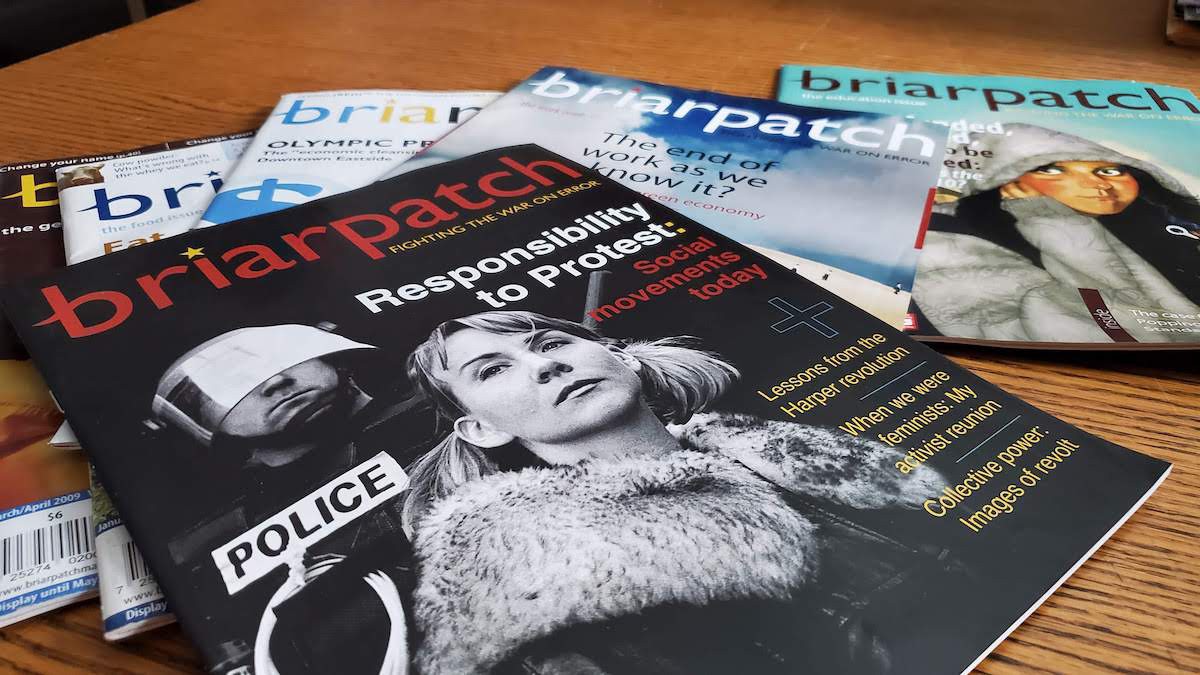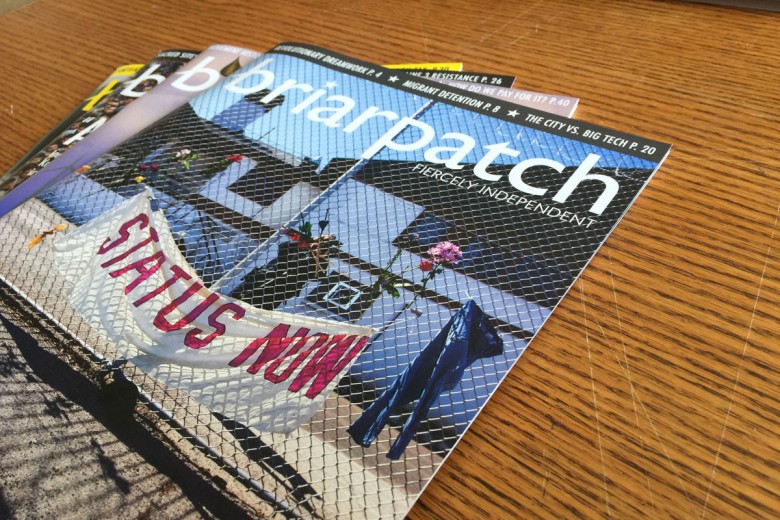In May 2009, Briarpatch publisher Shayna Stock began her day with a familiar but fruitless routine, shuffling through the morning mail looking for a particular letter. Nearly eight months had passed since she learned that the magazine’s application for federal funding had been placed in the approval queue. Since then, nothing. Projects stood waiting while the clock ticked.
At first, she wasn’t worried. Since first qualifying for assistance in 2004, Briarpatch had a good track record with the Canada Magazine Fund (CMF). Run by the Department of Canadian Heritage, the program aimed to shore up Canadian publishers in a U.S.-dominated market. Briarpatch easily met the base criteria, having over 250 subscribers, being based in Canada, and having primarily Canadian content. Although the grants were not huge – in the range of $15,000 to $40,000 and about 20 per cent of annual revenues – they made an outsized contribution to the magazine’s success, providing help with the costs of subscription drives and staff training, along with giving budget room to support freelance fees.
For 2008–2009, Stock and editor Dave Mitchell had worked out a modest $33,000 request for a direct mail subscription campaign and funds to hire an advertising consultant who would negotiate long-term advertising agreements. The application included evidence that previous funds had been put to good use and had a positive impact on subscription sales. Throughout the summer there was the usual back and forth with CMF staff to fine-tune the application and answer budget-related questions. On September 26, Stock and Mitchell had received a note stating Briarpatch’s “justification in support of the project was well received by the committee” and a recommendation would soon be made.
“Before [Harper] it was not politicized. It was invaluable, really important support,” recalls Mitchell.
Months ticked by with no further word. On February 2, 2009, Mitchell had sent an email inquiry. “No, we’re still waiting,” CMF project officer Nicole Jordan had responded, saying she would let them know “hopefully soon.”
On February 24, Stock had followed up with a longer email asking what should be done with project plans in the face of a looming end of fiscal year, with nothing yet approved. “I have informed management of your situation this morning. I’m not sure it will help, we’ll see,” Jordan had replied.
The response created pinpricks of doubt. Stephen Harper’s Conservatives had been elected in 2006 on a right-wing agenda that ran counter to Briarpatch’s left-wing editorial stance. Reassuringly, however, the funding process focused only on objective criteria without examining editorial themes beyond requiring Canadian content. “Before [Harper] it was not politicized. It was invaluable, really important support,” recalls Mitchell.
On May 6, a decision finally made its way into an official letter: “Your proposal was reviewed in light of the government’s ongoing objective to fund projects designed to identify and deliver measurable, tangible results which contribute to Program objectives and meet the needs of Canadians,” the letter had begun, hopefully.
The words that followed sat like cold stones on the page. “It is within this context that, on behalf of the Honourable James Moore, Minister of the Department of Canadian Heritage, I regret to inform you that your application has not been approved.”
Stones create ripples, though, ones the honourable minister likely didn’t intend, including re-energized community support for a magazine that was an indefatigable critic of his government’s agenda. In the immediate moment, though, the only ripple was one of shock. Speaking with CMF staff by phone, Mitchell had asked what had happened to a proposal that until now seemed greenlit. No clear answers were given.
It would take several years and an access to information request by the author to reveal that, behind the scenes, the program’s staff were also confused and being stonewalled by the minister’s office.
An April 3 email obtained through an access to information request revealed that the project had been recommended for funding and entered into the government payment system on December 5, 2008, and it was awaiting sign-off from the minister’s office. Staff had followed up “constantly,” but the project remained logjammed, according to the email written by CMF manager Jeanne Lahaie-Torres to the minister’s deputy director Scott Shortliffe.
“We’re not sure how to proceed and what we can say to the client,” she had concluded.
On April 14, she wrote again: “We still don’t have a decision on this file. There is nothing more I can do at my level. Do you want me to try higher up?” Grants and contributions director Yvonne Brisbois had responded in an April 21 note that the curious case of Briarpatch was not forgotten. A meeting had been scheduled with the minister’s office that day but had been cancelled, she wrote. “We continue to try and get a response,” her message had concluded.
On May 6, the word finally came down in the form of a single-line email from Shortliffe: “fyi – we can consider Briarpatch rejected.” Lahaie-Torres advised staff to prepare the standard rejection letter. When a project officer asked why, she wrote: “[The letter] template includes the ‘official’ reason for rejection. We have received no other comments or clarifications from MINO [the minister’s office]. Come and see me if you wish to discuss.” There is no public record of that discussion, if it occurred.
It would take several years and an access to information request by the author to reveal that, behind the scenes, the program’s staff were also confused and being stonewalled by the minister’s office.
The following day, the phone conversation with Dave Mitchell was described in a handwritten, unsigned staff note. Mitchell had been “deeply disappointed,” according to the note, and “asked if there were political reasons, (I said no) related to the content of [the] mag[azine] for example, for this rejection. I indicated that as far as I know there was no issue – we weren’t aware of any.”
The staff person noted Mitchell had asked for tips for a successful application. “I told him I didn’t really have any – but that applicants showing significant financial gains in their expected results were more likely to be approved.”
On May 21, CMF program staff had filed a ‘Request for change of fund commitment’ from $25,000 to zero, confirming the project had been in the budget pipeline before being rejected. On July 31, a ministerial report added a few spare details to the mystery: “File rejected by Minister Moore. Instructions given by the Chief of Staff at the Look Ahead Meeting of May 4, 2009 to inform client of the decision.”
Had Stock and Mitchell known the full reality, it may have saved them future toil and disappointment. Instead, they took heart from the phone conversation. If the government wanted to see financial progress, they could highlight Briarpatch’s improved revenue and subscription rolls via past projects. Stock burrowed into a new funding application for 2009–2010, a $33,545 request for online marketing and advertising development, in addition to a direct mail campaign and further staff training in publications management.
Applying to the Canada Magazine Fund was a painstaking, time-consuming task. The program demanded highly precise details on planned activities and well-founded, quantifiable analysis of expected outcomes. Applications would typically go back and forth multiple times until all the minutiae were hammered out, covering everything from how data would be converted for different software packages to how advertising brochures would be formatted.
"I indicated that as far as I know there was no issue – we weren’t aware of any.”
Disappointingly, the application ran aground when the funding envelope for Small Magazines Business Development Projects was eliminated during a program revamp. When applications opened for its 2011 replacement, Business Innovation for Print Periodicals, an undeterred Stock retooled Briarpatch’s request and dropped the ask by $11,000, again focusing on web development and marketing.
This time there appeared to be nothing standing in the way of approval. Correspondence between submitting and finalizing the application shows a period of minor tinkering over how expenses were expressed in various budget lines of the $22,453 request, while the overall project concept itself appeared to have the support of the newly renamed Canada Periodical Fund.
A funding commitment form for the full amount requested was formatted and finalized on December 3, 2010, and submitted to the grants disbursement system. A standard response notification acknowledged that the amount had been entered and that communication of approval to the client must await the minister’s signature.
Meanwhile, the Harper government had fallen under public scrutiny for ministerial interference in a different federal funding program, after evidence had surfaced that international cooperation minister Bev Oda had personally overturned a funding recommendation to support the work of KAIROS, a coalition of major Canadian national church bodies.
KAIROS was assured it was simply a difficult decision made within new priorities. The official reason might have held water if immigration minister Jason Kenney hadn’t told an Israeli audience the cut was because of Kairos’ stance on Palestine. The revelation would eventually lead to a full public inquiry into the affair.
Meanwhile, the situation at Briarpatch remained shrouded in mystery. Mitchell and Stock were confident their application had passed muster. Then everything happened all over again.
On February 9, 2011, program staff had received an internal notice of rejection from the minister’s office, signed by Minister Moore. An area on the form for providing a justification stated simply, “I do not approve this grant.”
Once again, the standard rejection letter that was sent to Briarpatch revealed none of this. Stock had reached out to director Scott Shortliffe for answers, and again there were none. “Talked to [Stock]. Very disappointed, asked if there was an appeal process, asked what more they could do in terms of measurable results […] I had to say that there is no appeal,” Shortliffe had written in a February 22 email.
Astounded, Stock hammered out a letter the very same day. “As you can imagine for a small magazine like Briarpatch, the implications of being denied access to this funding are significant,” she had written. “With an annual budget of just $135,000, this project funding would have represented about 17 per cent of our annual revenue – not to mention all the time and energy that our two-person staff has invested in the application process and project planning, which is now lost.”
Noting that the officer had indicated the project was “a solid one” and seemed confident in its approval, Stock had asked, “Do you have any insights whatsoever as to what happened to our application after it left your hands, and why it might have been denied?”
Again, the exchange prompted an internal search for answers. Asked for details, Shortliffe had further explained to the project staff that it was not “an eligibility question” but rather a “judgement call.”
“I realize that this is frustrating for the applicant, but there is no more information we can offer on the decision,” Shortliffe had written.
These were dark times in Canada: austerity deepened, police spied on Indigenous land defenders and environmentalists, scientists were silenced and dismissed by politicians, and the federal government prioritized militarization over public services.
If the Harper government sought to defund Briarpatch, it was successful. For Stock and Mitchell, there was no point in continuing to apply, knowing months of hard work could be overturned without explanation.
Briarpatch had been down this road before. In 1979, the magazine had abruptly lost the annual provincial grant it had grown to depend on for daily operations. The NDP had initially supported the magazine’s development but backed off when Briarpatch’s coverage of provincial policies around Indigenous and environmental issues started hitting close to home.
“How can I go to cabinet and ask them to approve funding for a magazine that is critical of uranium development?” an anonymous provincial official had told the Regina Leader-Post. A commentary in an NDP-affiliated newspaper, the Commonwealth, added that the government would be “ill advised” to support a critical news magazine because “of what the opposition could do with it in the legislature.”
Briarpatch was told they’d have six months to find new funding. Then even that assurance was pulled away without warning.
The magazine was thrown into an immediate crisis. A theme issue on disability rights was already on its way to the press. Half the staff members were laid off and the June 1979 issue was cancelled. Attempts to find replacement grants, including applications to the Donner Canadian Foundation and the Sask Sport Trust, were unsuccessful; neither agency included media undertakings among eligible projects.
“We’re not going to pack up and go home,” board member Gary Robins vowed. Fortuitously, they had started a side business setting type the previous year. First Impressions provided a lifeline, grossing $17,892.81 in 1979–1980.
The board launched a successful emergency fundraising campaign that raised nearly $10,000 in one-time and sustaining monthly donations before the year was out. The magazine also held its first $20-a-plate dinner – no small sum at the time – raising $3,400 in a single evening. By the end of fiscal year 1981, Briarpatch managed to pay its bills and realize a modest surplus of $1,696.65, prompting the Leader-Post to declare “a major victory” for the magazine.
“We’re not going to pack up and go home,” board member Gary Robins vowed.
Now, 30 years later, a similar scenario was in play. Many of the community-based organizations that had advertised in Briarpatch had been lost to decades of neoliberal austerity, leaving a budget hole that federal grants had come to fill, creating a false sense of stability. After three years of intensive, time-consuming work on project applications, Briarpatch emerged suddenly bereft of nearly 20 per cent of its planned budget and a nagging suspicion that politics had come to bear on the final decision.
In an echo of the 1980 crisis, Briarpatch launched the Deeper Roots campaign in 2010 to expand the sustaining donor base. The obstacles ahead were formidable, including an aging donor base and a younger generation used to free content.
“One thing that we’ve noticed is our donors are not our age by any means, and mostly very old, like plus-80,” past editor/publisher Valerie Zink reflected in a 2012 interview. “Certainly they are of all age categories, but it’s a bit concerning when we look through our donor appeals and it’s in this impeccable penmanship that you could have only gotten if you went to school in the ’30s, with a little shaky hand on top of that.”
Federally funded projects had pulled Briarpatch toward a national audience, fraying ties with older Saskatchewan readers who were also the magazine’s core donors. In the midst of all this, Briarpatch had launched a provincial publication, the Sasquatch, to serve the local readers, thinking they could duplicate the mix of ads, subscriptions, and union support that got Briarpatch off the ground. If the mix was still there, it was not strong enough to float two left-wing publications. There were no guarantees Briarpatch or the Sasquatch could survive Stephen Harper and Minister Moore.
The Deeper Roots campaign brought in $16,000 in its first year, falling short of lost funds. The Briarpatch board made the difficult decision to shutter the Sasquatch after eight issues.
Many of the community-based organizations that had advertised in Briarpatch had been lost to decades of neoliberal austerity, leaving a budget hole that federal grants had come to fill, creating a false sense of stability.
These were dark times in Canada: austerity deepened, police spied on Indigenous land defenders and environmentalists, scientists were silenced and dismissed by politicians, and the federal government prioritized militarization over public services. Undaunted, Briarpatch responded with stories of resistance on all fronts from a growing diversity of writers.
As anger against the Harper government grew, the Deeper Roots campaign chugged forward. By the third year, the campaign pulled in $45,000, eclipsing the lost federal grant. In September 2013, Briarpatch’s community supporters gathered at the Artesian concert hall in Regina to celebrate 40 years of publishing.
Gary Robins, who helped helm the publication through its first brush with funding cuts back in 1979, was one of the speakers. He noted that other publications came and went in perilous times, but Briarpatch had managed to stay steady on the strength of its loyal readers. “There is a good, strong base, and I think that’s really critical,” he said.
“For forty years readers have consistently and creatively risen to [Briarpatch’s] defence, often lending their scarce funds, but even more often and importantly, their time, tenacity, and passion,” Zink wrote in the magazine’s 40th anniversary edition.
Briarpatch’s experience with the Harper government revealed important lessons. First, external funding can be a great help for expanding independent media, but it can also introduce fissures and instabilities. While the current Trudeau government has relaxed its hand toward independent media like Briarpatch, governments are fickle. Things can change overnight. At those moments the true measures of sustainability come to the fore: not how much money is in the pot but how strong a publication’s social networks are. Briarpatch’s fundraising record is an important example of a community-generated solution to the problem of non-profit media sustainability. Every day remains a struggle and a reason for solidarity and support from readers.
This article is based on two previously published works by the author: “Staying Afloat While Stirring the Pot: Briarpatch Magazine and the Challenge of Nonprofit Journalism,” Anserj: Canadian Journal of Nonprofit and Social Economy Research 6, no. 2 (Autumn 2015): 5–27; and “National Dreams and Neoliberal Nightmares: The Dismantling of Canadian Heritage’s Periodicals Assistance Programs, 1989-2015,” Canadian Journal of Communication 42, no. 5 (December 2017): 805–27.







